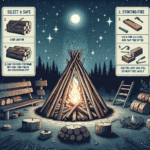Foraging 101: How to Identify and Harvest Wild Plants
Foraging is the act of searching for and gathering wild plants and fungi for food or medicinal purposes. This age-old practice has gained popularity in recent years as people seek to connect with nature, eat more sustainably, and learn about the plants that grow in their local environment. However, foraging can be a daunting task for beginners, as there are many plants that are toxic or inedible.
To help you get started on your foraging journey, here is a beginner’s guide to identifying and harvesting wild plants:
1. Safety first: Before you start foraging, it’s important to educate yourself on the plants that grow in your area. Take a foraging class, join a local foraging group, or invest in a good field guide to help you identify plants accurately. Never eat a plant unless you are 100% sure of its identity.
2. Start with easy-to-identify plants: Some common wild plants that are easy to identify and harvest include dandelions, clover, plantain, and chickweed. These plants are abundant in many environments and have few lookalikes, making them ideal for beginners.
3. Pay attention to the environment: When foraging, be mindful of where you are harvesting plants. Avoid picking plants near roadsides, industrial areas, or areas that have been sprayed with pesticides. Look for plants in clean, unpolluted areas like parks, forests, and meadows.
4. Harvest ethically: When foraging, only take what you need and leave plenty behind for wildlife and other foragers. Be respectful of the environment and never uproot plants unless you are sure they are invasive or abundant.
5. Know when to harvest: The best time to harvest wild plants is in the spring and early summer when they are young and tender. Avoid harvesting plants that are past their prime or have started to flower, as they may be bitter or tough.
6. Properly prepare and cook wild plants: Before consuming wild plants, make sure to wash them thoroughly to remove any dirt or insects. Some plants may also need to be cooked to remove any bitterness or toxins. Research different preparation methods to ensure a safe and delicious foraging experience.
Foraging can be a fun and rewarding way to connect with nature and expand your culinary horizons. By following these tips and doing your research, you can safely identify and harvest wild plants for a truly unique and sustainable dining experience. So grab your basket and head out into the great outdoors to discover the abundance of edible plants that nature has to offer.



